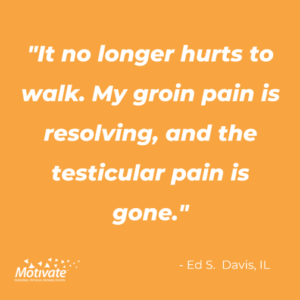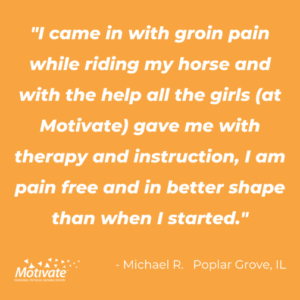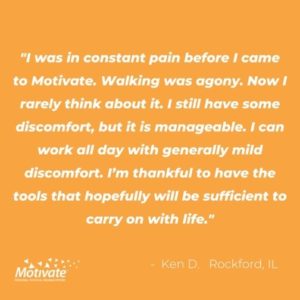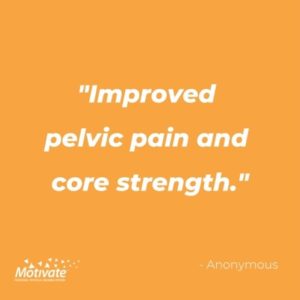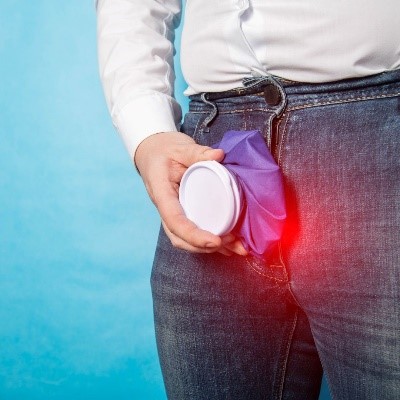Intro to Male Pelvic Pain
At Motivate, we strive to educate the public and increase awareness of men’s health for total body healing. This month our topic of conversation is… Male Pelvic Pain.
Male pelvic pain is a characterized by pain felt in the pelvis, genitals, groin, and/or abdomen. This pain can affect the urinary system, sexual functioning, and overall quality of life.
The two most common types of pain syndromes experienced by men are:
- Chronic Prostatitis and
- Chronic Pelvic Pain Syndrome
Prostatitis: inflammation and swelling of the prostate gland, which can cause:
• Painful and difficulty urination
• Frequent and urgent urination, especially at night
• Back, abdomen, groin, pelvic, and/or genital pain
• Pain with ejaculation
Chronic Pelvic Pain Syndrome: constant pain located in the pelvic girdle, which can cause:
• Genital, abdominal, low back, or buttock pain
• Frequent urination
• Pain with sitting
• Pain during and after sexual activity
Although these conditions may seem daunting, pelvic floor therapy can help! From modifying behaviors to retraining body mechanics, this month we will be highlighting healthy habits you can adopt to help reduce pain and improve your overall pelvic health.
Behavioral Awareness
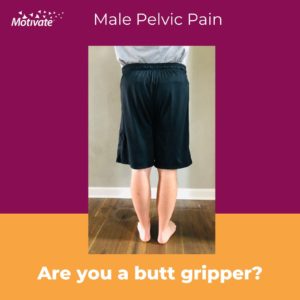 Did you know that you can experience pain relief just by letting go of your butt? Right beneath your glute muscle complex are your pelvic floor muscles, so when your body is holding unnecessary tension especially in the glutes it can lead increased pain in the pelvis. This is called “butt gripping,” coined by a PT named Diane Lee, in which dysfunctional posture patterns can lead to pelvic floor tightness, weakness, and pain.
Did you know that you can experience pain relief just by letting go of your butt? Right beneath your glute muscle complex are your pelvic floor muscles, so when your body is holding unnecessary tension especially in the glutes it can lead increased pain in the pelvis. This is called “butt gripping,” coined by a PT named Diane Lee, in which dysfunctional posture patterns can lead to pelvic floor tightness, weakness, and pain.
How do you know if you are clenching your glutes? Check in with your body! Are you stressed, cold, anxious, upset, or fearful? If so your flight or fight system is most likely activated and holding the body in a tense state, the most common area being the glutes.
To help reduce the clench, let go of your glutes by softening the knees and realigning the pelvis to be in a neutral state which will lead to less pain. Truly the more we are able to relax the more we can live pain-free!
Tissue Health
When people believe that they are about to do something where they may experience pain, such as bending to pick up clothes on the floor, lifting grocery bags out of the car, or kneeling we tend to do something called “pre-guarding.”
When we anticipate the onset of pain our muscles prepare itself by guarding or tightening in an effort to prepare itself for the impact of pain. Due to this phenomenon, we are teaching our muscles to constantly tighten prior to any functional movement which can make the painful experience even more intense. The best way to rid your body of pain specifically in the groin or pelvic floor we need to relax the muscles and reverse the tightening and pre-guarding.
At motivate, the best ways to reduce muscle tightness in the pelvic floor is through the use of foam rolling. Watch this video to learn our lower body foam rolling routine that promotes pelvic floor tissue health and reduces surrounding muscle tightness.
Strength through Stability
When men experience groin or pelvic pain, the cause may be due to ineffective muscle compensation developed over time, specifically the stronger muscles in the hips and back, compensating for the weaker muscles in the pelvic floor and core abdominals.
To retrain those muscle patterns, we at Motivate provide foundational exercises that focus on strength through stability, where we power the core by challenging the stability of the pelvis.
One effective exercise that helps to promote adequate muscle patterns and promote pain relief the birddog exercise.
Watch this video to learn how to create effective muscle patterns to aid in pain relief.
Functional Mobility
For Males, pelvic health recovery does not just stop at adequate strength and proper breathing. The final goal at Motivate is to combine all education learned towards your recovery and use it during functional mobility.
One of the main reasons pain returns post recovery is because we continue to move our bodies in ways that promoted pain and never learn how to safely position our bodies when performing functional tasks. For example, someone who always bends at the waist to lift groceries will have back pain that continues to persist after therapy compared to someone who learned how to adequately squat whose pain has now diminished.
Learning how to move in safe functional ways is key to reducing the return of pain.
Watch this video as we demonstrate to best and safest way to shoot a basketball with the help of proper breathing, strength, and stability without producing pain.
Testimonials
